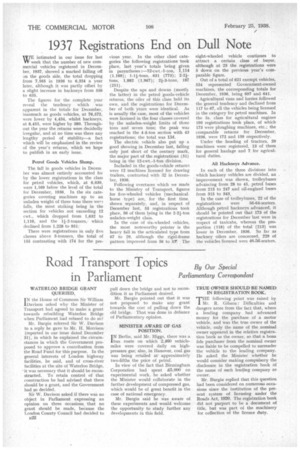1937 Registrations End on Dull Note
Page 60

If you've noticed an error in this article please click here to report it so we can fix it.
'ME intimated in our issue for last VV. week that the number of new commercial vehicles registered in December, 1937, showed a marked falling off on the goods side, the total dropping from 7,565 in 1936 to 6,334 a year later, although it was partly offset by a slight increase in hackneys from 556 to 635.
The figures for the complete year reveal the tendency which was apparent in the totals for December, inasmuch as goods vehicles, at 76,572, were lower by 4,434, whilst hackneys, at 8,455, were higher by 380. Throughout the year the returns were decidedly irregular, and at no time was there any lengthy period of stability—a fact which will be emphasized in the review of the year's returns, which we hope to publish in an early issue.
Petrol Goods Vehicles Slump.
The fall in goods vehicles in Decent her was almost entirely accounted for by the lower registrations in the class for petrol vehicles, which, at 6,030, were 1,169 below the level of the total for December, 1936. In the six categories covering machines up to an unladen weight of three tons there wer..., falls, the most striking being in the section for vehicles not exceeding 12 cwt., which dropped from 1,632 to 1,110, and the 11-2-tonners,• which declined from 1,228 to 951.
There were registrations in only five classes above 3-tonners, the total of 155 contrasting with 174 for the pre
vious year. In the other chief categories the following registrations took place, last year's totals being given in parentheses :-12-cwt.-1-ton, 1,114 (1,169); 1-1i-tons, 631 (773); 2-21– tons, 1,882 (1,967); 2i-3-tons, 187 (251).
Despite the ups and downs (mostly the latter) in the petrol goods-vehicle returns, the oiler of this class held its own, and the registrations for December of both years were identical. As is usually the case, most of the vehicles were licensed in the four classes covered by the unladen-weight limits of three tons and seven tons; the peak was reached in the 4-5-ton section with 43 registrations; the total was 134_ The electric vehicle also put up a good showing in December last, falling only just short of the century mark, the major part of the registrations (51) being in the 12-cwt.-1-ton division.
Included in the goods-vehicle return"; were 12 machines licensed for drawing trailers, contrasted with 32 in December, 1936.
Following overtures which we made to the Ministry of Transport, figures for five-wheeled vehicles (mechanical
horse type) are, for the first time, shown separately, and, in respect of December last, 55 registrations took place. 36 of them being in the 2-2i-ton unladen-weight class.
In the case of six-wheeled vehicles, the most noteworthy pointer is the heavy fall in the articulated type from 67 to 29, although the rigid-frame pattern improved from 56 to 57 The
eight-wheeled vehicle continues to attract a certain class of buyer, although at 25 the registrations were 5 down on the previous year's comparable figure.
Out of a total of 621 exempt vehicles, 534 represented Government-owned machines, the corresponding totals for December, 1936, being 697 and 641.
Agricultural vans and lorries followed the 'general tendency and declined from 117 to 67, all the vehicles being licensed in the category for petrol machines. In the 5s. class for agricultural engines 190 registrations took place, of which 173 were ploughing machines, etc.; the comparable returns for December, 1936, were 172 and 139 respectively.
Under the heading of tractors, 20 machines were registered. 13 of them for general haulage and 7 for agricultural duties.
All Hackneys Advance.
In each of the three divisions into which hackney vehicles are divided, an . improvement was shown, trolleybuses advancing from 28 to 45, petrol buses from 213 to 247 and oil-engined buses from 315 to 343, In the case of trolleybuses, 22 of the registrations were 56-64-seaters. Although petrol hackneys advanced, it should be pointed out that 173 of the registrations for December last were in respect of taxicabs, whereas the proportion (118) of the total (213) was lower in December, 1936. So far as hackney oilers are concerned, 229 of the vehicles licensed were 48-56-seaters.
































































































